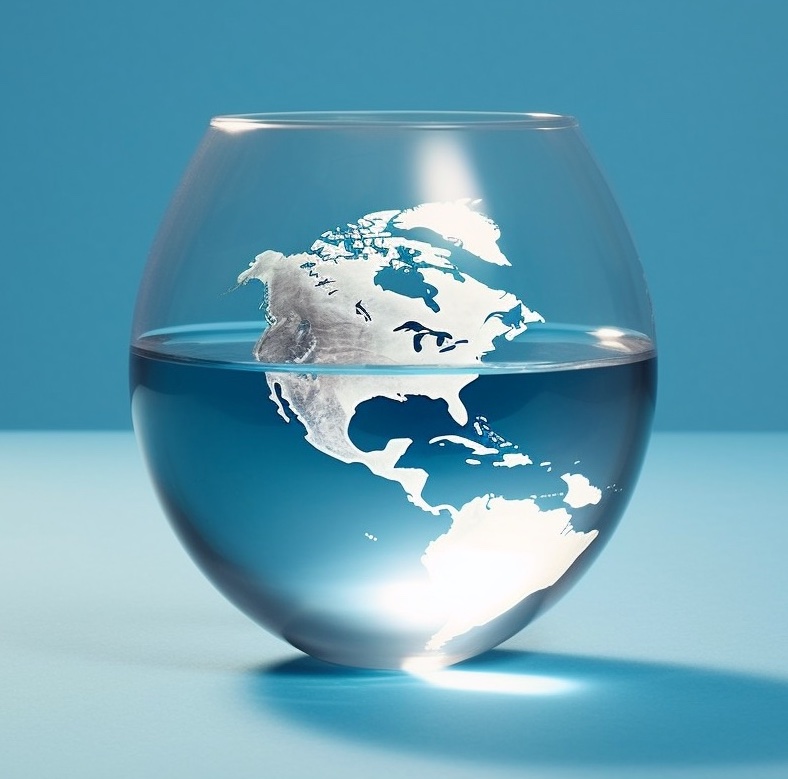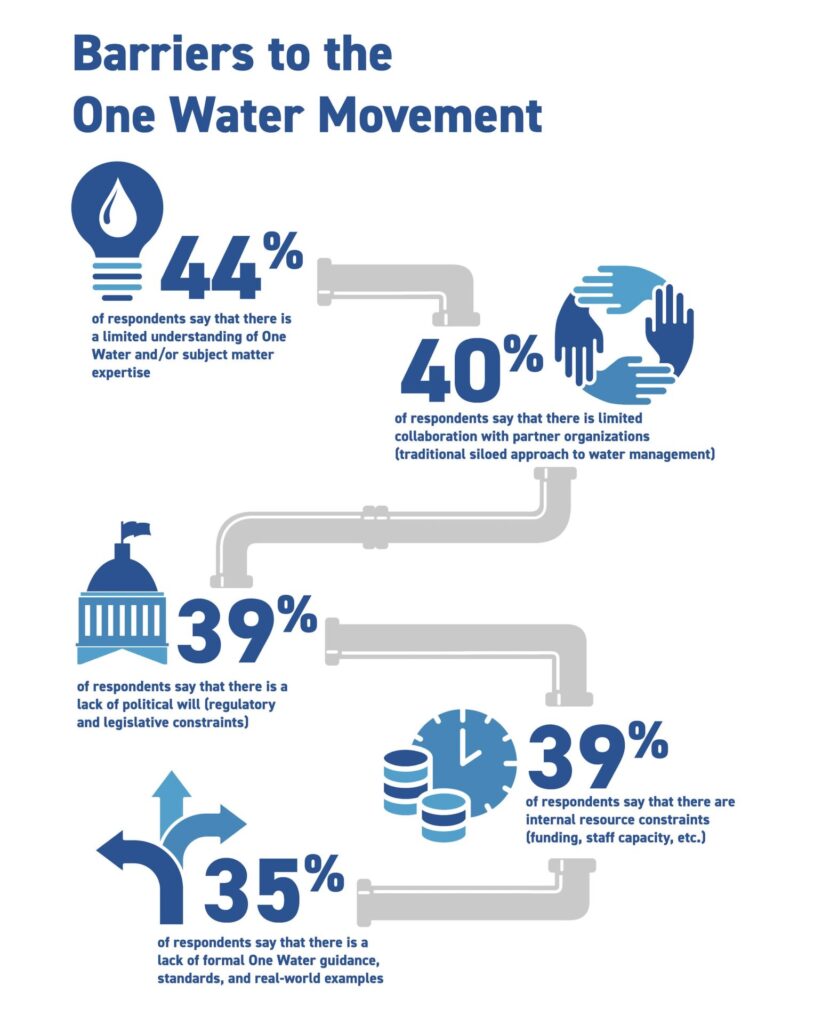& Construction

Integrated BIM tools, including Revit, AutoCAD, and Civil 3D
& Manufacturing

Professional CAD/CAM tools built on Inventor and AutoCAD
8 min read
Is One Water more than just an emerging catchphrase? Is it a key to solving the water industry’s challenges?

Changing weather patterns — including storms, droughts and dry conditions, intense flooding, and rising sea levels — demand action from the water industry to address the impacts of the climate crisis.
While policymakers and the public seek answers to improve water quality and accessibility, many utilities face tightening regulations, less funding, and aging water infrastructure in need of repair, replacement, or upgrades.
The compounding impact of these and other challenges has plunged the water industry on a collision course with change. The industry needs innovation to provide sustainable, reliable, and quality water for everyone.
This is where One Water comes in.
Traditionally, the water industry has treated drinking water, wastewater, stormwater, and existing water sources separately, each being managed through its own water systems and processes.
One Water seeks to break down this separation by viewing water as a circular, integrated resource. This holistic approach focuses on sustainability and resiliency, seeking long-term solutions to societal, community, and environmental needs.
One Water is rooted in the concept of Integrated Water Resource Management (IWRM), which is defined by the Global Water Partnership as “a process which promotes the coordinated development and management of water, land, and related resources in order to maximize the resultant economic and social welfare in an equitable manner without compromising the sustainability of vital ecosystems.”
IWRM envisions the lifecycle of water as one water system to be managed holistically. It provides a way of connecting water supply, wastewater, stormwater, and existing water source management.
While IWRM is a global initiative spearheaded by the UN, the term “One Water” is often focused on sustainable management of water within the United States, emphasizing water management for urban environments.
Both One Water and IWRM share principles and are sometimes used interchangeably to refer to the holistic one water management of water resources.
Formed in 2008, the US Water Alliance (USWA) is one of the leaders in the One Water movement. They created the One Water for America Policy Framework, which promotes seven main ideas for sustainable water management in the United States. The framework offers policy recommendations that span local, regional, state, and national levels to drive the adoption of holistic one water management.
USWA also developed the One Water Roadmap, which outlines strategies and areas of focus along with real-world examples of One Water in action. It offers practical actions and a path forward for leaders and communities implementing the One Water approach.
Other initiatives spearheaded by USWA include:
The Water Research Foundation (WRF) is another One Water organization, a nonprofit dedicated to advancing the science of water to improve the quality of life for all communities. WRF is made up of an integrated team of scientists and researchers with expertise in water reuse, wastewater and stormwater, as well as drinking water.
The organization brings the One Water approach to research and education in the water sector. Their work provides valuable insights and knowledge for solving the industry’s challenges from a One Water perspective.
One Water is guided by a few high-minded principles. They differ depending on who is explaining them, but we break them into five main categories.
This idea centers around the belief that all water – regardless of its origins and end use – is valuable. Water is essential and used in every aspect of human life: health, recreation, food production, industry and manufacturing, agriculture, energy production, and transportation, to name just a few.
Even though water is essential to everyday life, it is often ignored, polluted, and wasted. Valuing water means choosing to recognize its benefits and its integral role in human life and the environment (and acting accordingly).

The value of drinking water and natural water sources is easy to understand, but other forms of water have value, too. Wastewater, for example, contains nutrients and biogas that can be recovered and reused for agriculture or energy generation.
By seeing all water as valuable, communities can develop solutions for managing water as one, integrated resource.
This principle embraces the vast impact of water on society, the environment, and the economy.
One Water offers a new approach for municipalities and utilities considering projects to renew and repair water infrastructure.
Rather than the business-as-usual method of setting a single goal, One Water encourages programs that achieve multiple benefits.
Investments in capital renewal are significant and present a rare opportunity to positively impact a community.
Making the most of these investments by addressing multiple needs – like public health, economic conditions, disaster resilience, and regulatory compliance – results in lasting change.
One Water recognizes that the traditionally separate management of water no longer serves the needs of cities and communities.
Rather than focusing on individual areas, One Water looks at the full water lifecycle and every system for water management.
This high-level, water systems mindset enables water leaders to maximize connections between disparate processes. The idea being that decisions made from this way of thinking result in more effective, sustainable solutions.
One Water seeks to respond to the natural flow and cycle of water by examining challenges and opportunities within the context of the watershed.
A watershed is a geographic area of land that collects water from high ground and channels it into a lake, ocean, bay, river, reservoir, or other body of water.

Watersheds of varying sizes and geologic makeup feed every body of water, including water sources used by cities and communities. It’s where much of the water we drink may come from – or where it may lie protected from such usage.
Importantly, watershed-level planning and management involves analyzing issues and addressing priorities – like water quality and water quantity – before they reach the water source.
Tackling problems at the watershed-level results in broader change and benefits to multiple areas and communities within a region.
One Water’s focus on integration, systems-level thinking, and watershed-level solutions means the current way of designing and implementing solutions for the water industry is no longer viable.
Collaboration and connection are at the heart of the One Water movement.
Historically, engineering solutions for water management have been developed by planners, analysts, and designers. These professionals have held a limited role in the overall process: to design and implement a water system that is handed off to a municipality for long-term management.

One Water requires integration of a wide variety of stakeholders within individual communities: utilities, city planners, policymakers, businesses and industry, farmers, residents, and anyone who impacts or uses the water supply.
Simply put: Everyone has a stake in their community’s water supply. Only by working together can communities understand the challenges of water management and implement sustainable solutions that fit their unique needs.
Implementing One Water calls for a seismic shift in traditional ways of thinking about water and how it is managed.
With various systems, rules, regulations, and governance structures responsible for water management, wide-scale and high-level implementation in the United States is challenging, to say the least.
At the same time, every community has unique priorities, populations, ecosystems, and issues that call for customized water management solutions.

There is no one-size-fits-all answer, but One Water provides the guidance by which to plan, design, and implement realistic systems for sustainable and resilient water management.
There is already proof that the One Water approach works. Communities across the United States are acting on the principles of One Water and seeing positive results. 
The One Water movement won’t grow without more conversation about how these high-minded ideals are achieved in the real world. You can help spread the word by writing about it yourself or sharing the work of others:
We’ll keep writing about One Water, so subscribe to our newsletter at the bottom of this page for updates about the One Water movement.
Sign up for the One Water Blog newsletter, and we'll keep you updated about our top stories, along with the best content we find online. We only send out a newsletter when we have something interesting to share.
May we collect and use your data?
Learn more about the Third Party Services we use and our Privacy Statement.May we collect and use your data to tailor your experience?
Explore the benefits of a customized experience by managing your privacy settings for this site or visit our Privacy Statement to learn more about your options.